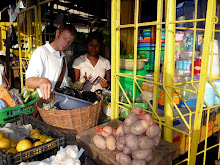After finally getting off the boat, we were still not in Tombouctou, but rather in the village of Kabara, about 20 kilometers from Tombouctou. Apparently there used to exist an off-shoot of the Niger river that ran straight from Tombouctou into the Niger, but it has since dried up. It took us an hour or so of haggling, but we got transport to Tombouctou itself. Three full grown adults, two fairly large backpacks, and one motorcycle. I’m not sure how we managed to fit, but we did. We arrived in Tombouctou (finally) and found a place to stay. As soon as we checked in, a city guide greeted us with “Welcome to the middle of nowhere.”
For the next few days we explored “the middle of nowhere” and the city that is Tombouctou. Tombouctou is often associated with the furthest corners of the globe, and rightfully so. The city sits on the cusp of the world’s largest desert and is hot and dry all the time. Despite the streets of sand, the mud buildings, and the remoteness of the place, it boasts a history that is second to none in terms of historical and geographic significance. Well before Europeans had stepped foot in Tombouctou or had even sailed to what would become known as the Gold or Ivory Coasts, Tombouctou was a bustling metropolis that housed one of the largest, if not the single biggest, collection of Islamic texts in the world and was home to a university population of more than 25,000 students. The importance of Tombouctou was very much derived from its geographic location on the northern most bend of the Niger River and the northern most point on the southern border of the Sahara to the Sahel. What that means is that it was the most centralized location for trade. Muslim traders from the Middle-east could reach the city and transport goods both up and down the Niger River. Therefore, the city began first as a trading center, but soon became an academic institution in and of itself as well. A Malian proverb states that “Salt comes from the north, gold from the south, but the word of God and the treasures of Wisdom come from Tombouctou.” Today, the city is but a shadow of the grandeur of what it once was. The ominous Sahara Desert has threatened to over run the city with sand and UNESCO has worked during the past decade to help save the city, its ancient books, and its history.
As we explored the city we were hounded by locals (the Tuareg) trying to sell us cheap jewelry and guided tours. Despite the hawks and the oppressive heat (it can easily, and often does, reach 115 degrees) the city was neat to explore. Tombouctou is home to three of the oldest mosques in West Africa and most of the other buildings are made in a traditional style from mud. Many of the doors of the houses are decorated with carvings and silver and are very impressive. The market was interesting and worth seeing as well as it was filled with slabs of salt from the desert. Quite possibly the most entertaining of our time in Tombouctou was a camel excursion out into the Sahara. Just before sunset one evening we dickered with a guide and he finally agreed to take us into the desert on camels. The trip was awesome. It was my first time on a camel and my first time into the Sahara, plus the sunset was beautiful. We walked out for a while with one of the Tuareg leading the camels and then stopped for a short break (when we stopped the Tuareg, as usual, tried to sell us jewelry). After playing in the sand and taking pictures, we got back on the camels and rode back in the dusk to Tombouctou. On the return trip I talked the guide into giving me the reigns and letting me “drive” the camel myself. I had a blast.
When we returned to Tombouctou, we went out in search of dinner and found a little street vendor who sold a number of different dishes. “Fatima” or “Fati”, as everyone called her, made us some noodles and red sauce, French fries (“Fati’s Frites”) and the best salad I have ever eaten in all of West Africa, restaurants included. After eating a very nice dinner, we did some wash one more time, packed our bags, and went to bed early as the adventure would continue the next morning at 4am when we got set to make the longest trek ever back to Accra.
Tuesday, May 5, 2009
Subscribe to:
Post Comments (Atom)















































No comments:
Post a Comment